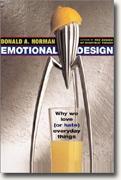Donald A. Norman
book reviews:
· general fiction
· chick lit/romance
· sci-fi/fantasy
· graphic novels
· nonfiction
· audio books
· author interviews
· children's books @
curledupkids.com
· DVD reviews @
curledupdvd.com
newsletter
win books
buy online
links
home
for authors
& publishers
for reviewers

 |
Emotional Design: Why We Love (Or Hate) Everyday Things Donald A. Norman Basic Books Hardcover 256 pages December 2003 |
|
The most interesting revelation in Emotional Design visits the reader early on: attractive things work better than ugly ones.
The result of the ATM experiment implies that an attractive thing makes a person more relaxed and a relaxed person is better at problem solving than a tense one. These findings also emphasize the core of Emotional Design, in that emotion plays a significant role in product design. Of course there are many situations where work needs to be accomplished using both creative thinking (positive emotions such as light music) and focus (negative emotions using beeps to signal warnings) and designers often factor both these when manufacturing for the real world. Norman explains the psychology behind our love (or hatred) of things by outlining the three levels of brain functioning: visceral, behavioral, and reflective. The visceral response is our first gut reaction to things. For example, most people have a positive visceral reaction to the Mini Cooper. This also explains why many books have attractive covers on the outside to prove as a hook to a potential reader who has many choices. The behavioral aspect of response is the brain’s response to the pleasure and effectiveness of use of a product. For instance, if a car is easy to drive, it scores high in the behavioral design department. Finally the reflective aspect of our emotions is associated with long-term response — memories provoked by a certain object (such as photographs). Pride of ownership and brand recognition are key elements of design that cater to our reflective levels of thought. Design of everyday objects focuses on these three levels of human emotion. Some departments might score higher than the other. A black and white photograph might not score very high in the visceral (or behavioral) department but be way up in the reflective department. Emotional Design sprinkles numerous interesting examples of design throughout the book and these are interesting to read in their own right. One instance shows that Betty Crocker did not score very high with cake mixes that needed just water (high on behavioral but very low on reflective) so they added the “add an egg” step to the mix procedure. This simple act of adding an egg to the mix gave the user a strong sense of accomplishment and the product did much better (due to its high scores in the “reflective” emotions area). Toward the end of the book, Norman loses his focus on the thesis of the book. The book meanders from discussion of video games to cellular phones and finally robots as emotional machines. These topics are all indeed tied to “emotional design” but the chapters ramble too much. This is not to say that each subset is not interesting enough in its own right — it is. But Norman fails to bring all of it together cohesively. By the end of the book, the reader comes away with a lot of wonderful information but might wonder if the titular question: “Why we love or hate everyday things” has been answered effectively. Emotional Design is an informative and enjoyable book but loses its focus often. Nevertheless, readers will enjoy learning the basic principles of object design and then have fun applying these to everyday things around them. © 2004 by Poornima Apte for Curled Up With a Good Book |
|
|
|
 Click here to learn more about this month's sponsor! |
|
| fiction · sf/f · comic books · nonfiction · audio newsletter · free book contest · buy books online review index · links · · authors & publishers reviewers |
|
| site by ELBO Computing Resources, Inc. | |
 Donald Norman, an expert in the design of human-centered products, outlines an experiment carried out in Japan that focused on “attractive” ATM’s as opposed to “unattractive” ones. The Japanese researchers tested different ATM’s on users—all these machines had the same buttons and identical functions but some of them were prettier with better layouts and screens. The results: users consistently found the attractive machines to actually work better than the unattractive ones. Norman explains the results thus: “attractive things make people feel good, which in turn makes them think more creatively. How does that make something easier to use? Simple, by making it easier for people to find solutions to the problems they encounter.”
Donald Norman, an expert in the design of human-centered products, outlines an experiment carried out in Japan that focused on “attractive” ATM’s as opposed to “unattractive” ones. The Japanese researchers tested different ATM’s on users—all these machines had the same buttons and identical functions but some of them were prettier with better layouts and screens. The results: users consistently found the attractive machines to actually work better than the unattractive ones. Norman explains the results thus: “attractive things make people feel good, which in turn makes them think more creatively. How does that make something easier to use? Simple, by making it easier for people to find solutions to the problems they encounter.”